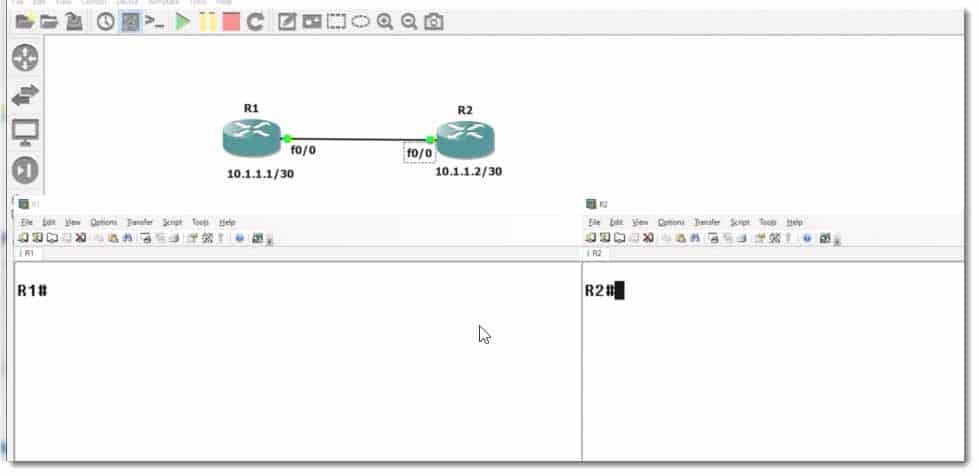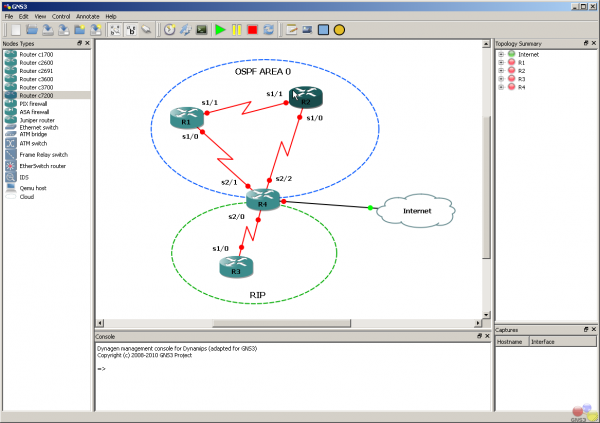Cisco Router Ios Image Gns3 Labs
Posted By admin On 04.01.20
. If needed, Download and Install Solarwinds TFTP Server. Place the New Cisco IOS Image file in the TFTP Server Root Directory.
Configure your TFTP Server and Cisco device to be within the same ip subnet, ie; 10.1.1.1/24 & 10.1.1.2/24. Ensure you have Ethernet connectivity from your TFTP server to the Cisco device which you’re upgrading. Copy the new image file from the tftp server to your Cisco device, you will be prompted to erase the flash memory. Once the new Cisco IOS Image is copied to the device flash memory, reboot the device and verify the upgrade was successful. Lab Instruction Please note that this lab requires a REAL Cisco Router or Switch to perform as GNS3 does not load images from flash memory. You can however perform this procedure on GNS3 but you will not be able to reboot the device and verify a successful upgrade. Upgrading the Internetwork Operating System (IOS) on a Cisco device is a pretty common procedure as updated IOS images are released at least once every three months to fix bugs and provide new features and enable new device hardware.
First off you’ll need a TFTP server installed and running on your PC with a crossover cable running from your PC to a router, or a regular patch cable running from the PC to a switch. To complete the 3rd objective of this lab you’ll need a console session to a Cisco router or Switch. Ensure that the IP Address you’re assigning to the Cisco device is in the same subnet as the PC.
For this lab, we’ll use 10.1.1.1/24 for the PC and 10.1.1.2/24 for the Cisco device. The objective requires you to configure the IP address on the Ethernet interface connected to the PC. In the example shown below, interface FastEthernet0/0 is directly connected to the PC; Router con0 is now available Press RETURN to get started. Router enable Password: Router# configure terminal Enter configuration commands, one per line. End with CNTL/Z. Router(config)# interface fastethernet 0/0 Router(config-if)# ip address 10.1.1.2 255.255.255.0 Router(config-if)# no shutdown Router(config-if)# end Router# To ensure you have Ethernet connectivity between the Cisco device and your computer you can execute the ping command as shown below. Router#ping 10.1.1.1 Type escape sequence to abort.
Sending 5, 100-byte ICMP Echos to 10.1.1.1, timeout is 2 seconds:!!!!! Success rate is 100 percent (5/5), round-trip min/avg/max = 1/1/1 ms Router# Once you’ve verified that you have IP connectivity to your PC your then ready to copy the new image into the devices flash memory. You achieve this by executing the copy tftp flash command in privileged mode. After executing this command you’ll be prompted for the IP address of the tftp server and the file name of the image you wish to copy from the TFTP Server to the flash memory. Router# copy tftp flash Address or name of remote host ? 10.1.1.1 Source filename ? C2600-adventerprisek9-mz.124-15.T11.bin Destination filename c2600-adventerprisek9-mz.124-15.T11.bin?

Accessing tftp://10.1.1.1/c2600-adventerprisek9-mz.124-15.T11.bin. Erase flash: before copying? confirm Erasing the flash filesystem will remove all files!
confirm Erasing device. Eeeeeeeeeeeeeeeeeeeeeeeeeeeeeeeeeeeeeeeeeeeeeeee.erased Erase of flash: complete Loading c2600-adventerprisek9-mz.124-15.T11.bin from 10.1.1.1 (via FastEthernet0/0):!!!!!!!!!!!!!!!!!!!!!!!!!!!!!!!!!!!!!!!!!!!!!!!!!!!!!!!!!!!!!!!!!!!!!!!! OK - 34634180 bytes Verifying checksum. CCCCCCCCCCCCCCCCCCCCCCCCCCCCCCCCC OK (0x8E89) 34634180 bytes copied in 486.894 secs (71133 bytes/sec) Router#.
Once you’ve copied the image to flash, reboot the Cisco device and verify that the image loads successfully. If the IOS fails to load you’ll need to perform an IOS recovery procedure which is in the next lab.
Router# reload System configuration has been modified. yes/no: no Proceed with reload? confirm%SYS-5-RELOAD: Reload requested by console. Reload Reason: Reload Command.
System Bootstrap, Version 12.2(8r) cmong 8r, RELEASE SOFTWARE (fc1) Copyright (c) 2003 by cisco Systems, Inc.
Contents. Objectives and Skills Objectives and skills for for Cisco CCENT certification are covered in detail in other lessons. This lesson helps you:.
Set up a lab environment to practice hands-on activities with Cisco routing and switching using GNS3. Readings. Multimedia.
Activities. Review. Download and install GNS3 on your system. Review, and. Add one or more Cisco router IOS images to Dynamips/GNS3. Be sure to include an image from the 2600, 3600, or 3700 series that supports a Network Module slot to allow for both routing and switching configurations.
Add a router image. Add the router image again as an EtherSwitch router. Test GNS3 router support. Add a router to a new GNS3 project or use the project created above. Add a VPCS PC to the project. Add a link to connect the following.
PC1 Ethernet0 R1 FastEthernet0/0. Start the devices. Open the console for PC1.
Set the IP address for PC1 using the following command. Ip 192.168.1.11 255.255.255.0 192.168.1.1.
Cisco Router Ios Image Gns3 Labs 7
Open the console for R1. Set the IP address for R1 using the following commands. Enable configure terminal interface fastethernet0/0 ip address 192.168.1.1 255.255.255.0 no shutdown exit exit.
Open the console for PC1. Ping R1 using the following command. Ping 192.168.1.1. Test GNS3 EtherSwitch router support.
Add an EtherSwitch router to a new GNS3 project. Add two VPCS PCs to the project.
Add links to connect the following. PC1 Ethernet0 ESW1 FastEthernet1/1. PC2 Ethernet0 ESW1 FastEthernet1/2. Start the devices.
Open the console for PC1. Set the IP address for PC1 using the following command. Ip 192.168.1.11 255.255.255.0 192.168.1.1. Open the console for PC2. Set the IP address for PC2 using the following command.
Cisco 2960 Ios Image
Ip 192.168.1.12 255.255.255.0 192.168.1.1. Using the console for PC1, ping PC2 using the following command.
Ping 192.168.1.12. Using the console for PC2, ping PC1 using the following command.
Ping 192.168.1.11. If the pings are not successful, try replacing the EtherSwitch router with an Ethernet hub or switch and repeat the tests.
Lesson Summary. GNS3 is a graphical network simulator supporting a variety of products from vendors including Alcatel-Lucent, Arista, Cisco, Extreme Networks, Fortigate, Juniper, Microtik, and Vyatta. GNS3 is available for Windows, Linux, and Mac OS X platforms. The standard GNS3 Windows installation package includes WinPcap, Wireshark, Dynamips, QEMU, and VPCS Virtual PC Simulator.
WinPcap provides a packet-capture and filtering engine for Windows systems. Libpcap provides a packet-capturing and filtering engine for Unix-like systems. Wireshark is a free and open-source packet analyzer.
Dynamips is an emulator computer program that was created to emulate Cisco routers. QEMU (Quick Emulator) is a free and open-source hosted hypervisor that performs hardware virtualization, and is used by GNS3 to run Cisco ASA, PIX and IDS, as well as conventional operating systems. VPCS provides a simulated command-line interface for hosts connected to routers in a GNS3 / Dynamips network. The GNS3 installation package does not include Cisco IOS images. IOS images must be loaded separately after GNS3 is installed. GNS3 cannot run Cisco switch IOS images, but does support EtherSwitch network modules to provide switching configurations on supported routers.
GNS3 support for EtherSwitch network modules includes Cisco routers from the 2600, 3600, and 3700 series. The GNS3 user interface includes windows for node types, network topology, topology summary, and the Dynagen console for Dynamips.
Each IOS image must be loaded into GNS3 and configured with an Idle PC value before it can be used in a network topology. After adding devices to a network topology, the devices must be started in order to access the device console. Consoles are accessed through terminal emulation, Telnet, or SSH connections. Network topologies may be saved and opened using the GNS3 File menu.

Key Terms ping A computer network administration software utility used to test the reachability of a host on an Internet Protocol (IP) network and to measure the round-trip time for messages sent from the originating host to a destination computer and back. Review Questions.